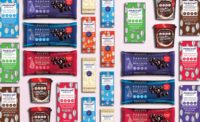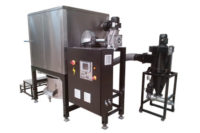Cynthia Calvert-Copeland, the owner of aspecialtybox.com, a supplier of gifting boxes to the confectionery industry, remembers exactly when her husband, Bill, told her he wanted to switch careers and become a chocolatier.
“We were at the 2001 Philly Candy Show in Valley Forge, Pa.” she says. “Our booth was all the way in the back of the hall. And we happened to be directly across from the Birnn Chocolates of Vermont booth. So he turns to me and says, ‘I want to do that.’”
Anyone who’s met Bill Copeland knows that behind that fun-loving and sometimes frenetic persona is a man who’s curiosity about the world and the way it works fuels a creative and cutting-edge mind.
Hence, Cynthia knew her husband’s comments weren’t to be taken lightly; this wasn’t a mere flight of fancy. Rather it was a flight of force, one that’s brought not only their businesses closer, but the two of them as well.
In thinking about Bill’s pronouncement, Cynthia also saw the benefits in supporting the career shift.
“He has an extremely good eye as well as a good palate,” she says. “He can call out ingredients in foods and tell you what they are. He also has a trained eye, capable of detecting color shifts from 1 to 2 Delta [a measure of color shift based on a numerical comparison to a standard].
“Also, when I thought about it, it would be helpful for us as a stock box manufacturer catering to chocolatiers and chocolate makers to know what their needs are, to get their point of view,” Cynthia added.
And that’s when Bill’s 10-year journey to become a certified master chocolatier began. First, he started with the basics about chocolate by enrolling in a 12-week course organized by Ecole Chocolat in Vancouver.
“They taught me about tabling, tempering, shelling, moulding, enrobing and how to make centers,” he explains. The next stop was at Barry Callebaut’s headquarters in Belgium for additional training. A PMCA course taught by Maurice Jeffery and Jean-Pierre Wybauw — both global confectionery all-stars — followed. By 2010 Bill had completed the master chocolatier program run by Valrhona Chocolate in France.
“It’s all about process controls,” he explains. “If you control the environment, you control the chocolate.”
Having worked at Eastman Kodak across nearly all its departments, as well as starting his own digital imaging business, Copeland knew something about process controls. That knowledge base led him to package design and production, which eventually led him to Cynthia. They married in 1998.
Having worked in and then inherited the Professional Image packaging business from her father, Cynthia — with Bill’s help — formed aspecialtybox.com company in 2000 to address a niche in the small- to midsized chocolate retail segment.

“Cynthia was looking to hire a new production manager for Professional Image,” Bill explains. “In comes an application from someone who worked at Quincy Ward Box Co., Russell Stover’s box-making subsidiary. Well, it seems the company was going to simply focus on supplying its parent company with boxes and no longer sell its overflow boxes, especially their heart boxes, to the retail confectionery community. Right away we realized there was a niche that was being neglected. We hired the candidate who then introduced us to all the customers.”
Retail chocolate companies were desperate to get a high-end, rigid boxes to pack their chocolates in, Cynthia says. The business plan was simple, but effective: Provide small chocolate retailers with stock boxes that they could order by the pallet at an affordable price. Make them attractive and make it accessible on the web.
“We brought in more contemporary designs and made it all available on the website,” Bill adds. Throw in ribbons and bows and it’s one-stop shopping. Of course, the then chocolatier-to-be was instrumental in doing all the website design and execution.
“On Thanksgiving weekend, Black Friday/Cyber Monday, we were sitting around the table when I heard this special ring go off on his phone,” Cynthia says. “I turned to Bill and he had a large smile on his face. ‘Honey, those are orders coming in.’”

During his quest to become a chocolatier, Bill was also involved in helping the aspecialtybox.com part of the business grow. Moreover, his and Cynthia’s attendance at various industry shows and events expanded his knowledge as well as his contacts with chocolate experts within the industry. He credits a whole host of individuals in sharing their experiences with him. “Without them I would still be making boxes!”
“One never stops learning about chocolate; it’s an ongoing process,” he says.
And that’s what the story of Glacier Confection — the company was named after Bill’s favorite national treasure, Glacier National Park, which is where he and Cynthia were married— is all about…an ongoing process. Since its founding in 2009, Glacier Confection has evolved from a small production facility and product development center to a much larger operation featuring a 50,000-sq.-ft. warehouse/factory, two retail shops and a bean-to-bar/café site.
Throughout this evolution, Bill has stayed true to his founding mission, which involves helping veterans and their families by making the best possible chocolate products in the most sustainable way possible. Thus, in addition to learning the craft and becoming a master chocolatier, he and Cynthia also visited several cocoa origin sites, one of which was the famed Maranon Valley of Peru.
It was there — actually a clandestine trip — that they met the farmer who grows the rare Fortunato #4 cacao pods the company uses in some of its chocolates. The location is kept secret to protect the unique pods, Bill explains, adding that they are only one of out of a dozen foreigners who have visited the site.
The K-State connection
Unless you’re in the business, few individuals are familiar with Kansas State University’s bakery science degree. And yet, the Manhattan, Kan.-based research university provides candidates for some of the largest bakery operations in the United States.
It also does so for Glacier Chocolate and its co-owners, Bill and Cynthia Copeland. Hannah Schriever, director of operations; Colton Rohr, director of sales; Alex Morehead, chocolate concierge manager; and Erin Groff, production manager, have K-State degrees and each hold responsible positions at the company. Schriever, a former pastry chef, holds a degree in hospitality and bakery science while Rohr and Groff have degrees in hospitality.
It also started when Schriever was working at one of Tulsa’s elite golf venues, a place where Bill, an avid golfer, frequented. He was in need of help given Glacier Confection’s growth. It didn’t take long for the two to connect, and Schriever didn’t hesitate in joining the master chocolatier’s team.
“I started as a chocolate concierge and eventually transitioned to production manager,” she explains. “I’m 100 percent fulfilled. I didn’t take this job for the money; it has intrinsic value.”
Schriever’s quick ascension in Glacier prompted Copeland to establish a relationship with Kansas State University, which resulted in Rohr, Groff and Morehead’s hires in 2014 and 2015, respectively. Schriever’s subsequent promotion from production manager to director of operations in 2017 led to Groff’s promotion from assistant production manager to production manager that year.
Groff, who admits that her progress from chocolate concierge to an assistant and now supervisory role involved a steep learning curve, embraces the ongoing challenges of maintaining a high level of quality while constantly looking to improve efficiency.
And Rohr, who’s been instrumental in organizing the opening of Glacier Confection's new bean-to-bar/café site, has blended his various skills to become the ideal chocolate host for an increasing number of chocolate tastings and private parties.
Ironically, it was at a “leadership retreat” that was hosted by Bill and Cynthia in 2016 at their vacation home in Colorado that the “City of Chocolate,” the name Schriever uses for the bean-to-bar concept, came to fruition.
As Bill Copeland explains, he was looking to hire smart and energetic individuals to help grow Glacier Confection. He didn’t realize the path to such individuals would lead him to the “Little Apple (Manhattan, Kan.)” and K-State. And yes he’s now a big fan of the Wildcats.
But there’s no secret to Bill and Cynthia’s success. He doesn’t shy away from revealing how he produces his chocolate products or what goes into more than 100 recipes (70 percent of which he developed) for his line of truffles. As expected, he uses only natural, premium ingredients.
Besides, “No one really wants to put in the work I do,” he says.
Nor take the risks he and Cynthia do. For example, when Bill opened his retail store in Tulsa’s Arts District, the tiny 2,500-sq.-ft. shop was the lone retail establishment on Brady St. at the time. It was a place that was just beginning to undergo a transition. Today, the Tulsa Arts District is one of the city’s most vibrant and “hippest” neighborhoods.
The transition from work shop to retail store took place in 2010. And it didn’t take long before professionals and consumers took notice. Candy Industry Magazine proclaimed Glacier Confection as one of its five “Cutting-edge Chocolatiers” in its September 2011 issue. Dessert Professional magazine included the company as one of the Top 10 chocolatiers in its December 2011 issue and The Food Network listed Glacier Confection in the Top Ten Cocoa Power In America. More accolades and recognition followed.
This overnight success, of course, didn’t happen, well, overnight. Copeland spent time not only developing the recipes but the techniques as well. Again, there are no secrets here, just patience, perseverance and luck, lots of it he is quick to add.
Truffle production begins with the painting of the moulds with colored cocoa butter. It takes a steady hand and — be it by paint brush or air gun — an appreciation for nuance and artistry, as well as a flair for color.
Once the moulds set, the shelling process begins. Initially done by hand at the Brady location, all production now occurs at the newly occupied, 50,000-sq.-ft. 11th St. location.
The building also serves as a warehouse and provides ample room for Glacier Confection’s semi-automated production process, which includes a Hacos moulding line and a Savy Goiseau enrobing line as well as four JKV units for smaller volumes.
As Bill explains, it takes about three days to complete a truffle production run, beginning with the painting of the moulds to shelling to adding centers and then demoulding and packing.
“It’s still a hand-crafted operation,” he says. “And with the equipment we have, it provides us with enormous flexibility to change scheduling as orders come in.”
And orders have been coming in, not just from the original Brady St. shop, but from the newly opened Utica Square location (January 5, 2018) as well as the bean-to-bar/café location in the Archer Building, also in the Tulsa Arts District.
“We were fortunate to take over the old Russell Stover retail shop location in Utica Square, which is one of the prime outdoor mall locations in Tulsa,” says Bill.
The 1,100-sq.-ft. free-standing shop, which features a one-of-kind time piece in the front, was completely remodeled inside and now includes a bright interior with display cases and a gelato serving section.
“We offer about 50 different kinds of truffles as well as our single-origin bars and some panned items,” he says. “Our sales have exceeded expectations and we’re ecstatic to be here.”
When quizzed about the average cash register ring, Bill shared that customers typically pluck down about $35 per visit. Average annual sales should top $1 million at the location, he adds.
The indoor and outdoor café seating allows shoppers at the mall to enjoy a sweet treat. For the trained observer, it’s also a showcase for some of the company’s innovative packaging.
For example, the single-origin bars come in an oversized, plain white box, which nestles a 100-gram bar. The opening flap, when turned over, provides a global map on the inside, pinpointing the origin of the bar.
“We wanted to come up with something original,” he explains. “We wanted to take advantage of the negative space [blank white background] and simply put our logo and the country of origin. It really differentiates us from others.
“On the inside of the box, we can put a story about where the cocoa is from, but right now we simply wanted to illustrate the country of origin,” Bill adds.
There’s also an Oklahoma state-shaped box that’s perfect for tourists wanting to carry a sweet souvenir back home.
“I found a map of Oklahoma detailing the Indian tribes in the area, which is really unique,” he says.
Again, it’s about presentation and merchandising. That reminds Bill of the time he and Cynthia created a display box with a window that protects beautifully painted truffles.
“I came up with a conical-shaped tray whereby the truffle sits in a well that's wider on the bottom and narrower on top,” he explains. You then have a see-through window in the box lid that shows off all the beauty of the truffles, but the tray prevents them from sticking to the window. There’s about a millimeter gap between the window and the top of the truffle.”
That creation reflects exactly what Cynthia mentioned earlier, about learning the needs of chocolate makers. To that end, Bill has now taken the chocolate business to its ultimate end, making chocolate on site from bean to bar.
The move stemmed from Bill’s desire to not only produce his own chocolate from fine flavor beans, but to “demystify the process of chocolate making at a micro level.” The 5,000-sq.-ft. bean-to-bar operation in the historic Archer Building — the 100 year-old abandoned warehouse underwent a $17-million renovation and now houses 35 artists’ studios and 14 apartments — will invite patrons to see chocolate production through a floor-to-ceiling glass wall.
An oval bar area in front of the see-through production area enables customers to enjoy cocktails, wine and craft beers while sampling Glacier Confection’ chocolates, macarons, and gelato. Additional tables to the left of the bar provide ample room for educational sessions, supplemented by a two 75-inch television screens.
“We’re offering tasting experiences as well as classes on the basics of chocolate making,” says Bill. “The venue will also be open for hosting events and private parties.”

More importantly, Glacier Confection will be using the couverture that it produces. It also looks to supply bakeries and high-end chefs with its product. “I want us to be our biggest customer,” he says.
It’s important to note that Bill and Cynthia’s quest to demystify chocolate begins with employees who are hired; all go through a month-long training process focusing on how to handle and serve chocolate as well as customer interaction. It plays a critical role in the company’s growth (See K-State Connection sidebar).
Both see plenty of opportunity to serve the local populace as well as chocolate aficionados throughout the United States through their multi-segmented chocolate operation as well as the close connection to packaging.
In their case, it’s thinking about the bean in the box.




























